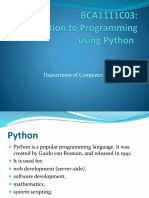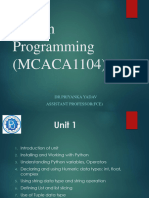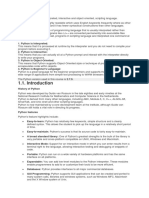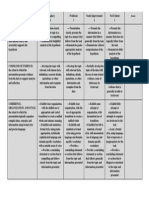Getting Started Python Chapter 5 NEW 14-09-2024
Getting Started Python Chapter 5 NEW 14-09-2024
Uploaded by
homig947Copyright:
Available Formats
Getting Started Python Chapter 5 NEW 14-09-2024
Getting Started Python Chapter 5 NEW 14-09-2024
Uploaded by
homig947Copyright
Available Formats
Share this document
Did you find this document useful?
Is this content inappropriate?
Copyright:
Available Formats
Getting Started Python Chapter 5 NEW 14-09-2024
Getting Started Python Chapter 5 NEW 14-09-2024
Uploaded by
homig947Copyright:
Available Formats
Chapter 5
Getting Started with Python
Introduction:
Python was created by Guido Van Rossum during his tenure at CWI (Centrum Wiskunde &
Informatica), a National Research Institute for Mathematics and Computer Science in the
Netherlands. The language was released in 1991 and was named after the BBC comedy
series from the seventies, “Monty Python’s Flying Circus.” Python supports both
procedural and object-oriented programming approaches and is free to use.
Features of Python:
High-Level Language: Python is a high-level programming language that is free and
open-source.
Interpreted Language: Python programs are executed by an interpreter, making it an
interpreted language.
Readability: Python programs are easy to understand due to their clearly defined
syntax and relatively simple structure.
Case Sensitivity: Python is case-sensitive, meaning that `NUMBER` and `number` are
treated as distinct identifiers.
Portability: Python is portable and platform-independent, capable of running on
various operating systems and hardware platforms.
Rich Standard Library: Python includes a rich library of predefined functions.
Web Development: Python is useful in web development, with many popular web
services and applications built using the language.
Indentation: Python uses indentation to define blocks and nested blocks, ensuring a
clean and readable code structure.
Easy to use: It is easy to learn and use
Working with Python
To write and run a Python program, you need to have a Python interpreter installed on your
computer, or you can use an online Python interpreter. The interpreter is also referred to as
the Python shell. Below is an example of what a Python interpreter screen looks like (as
shown in Figure.
Figure 1 Python interpreter or shell
MOHAN C ,HOD DEPT. OF COMPUTER SCIENCE Page 1
In the above screen, the symbol >>> is the Python prompt, which indicates that the interpreter
is ready to take instructions. We can type commands or statements on this prompt to execute
them using a Python interpreter.
Execution Modes There are two ways to use the Python interpreter:
a) Interactive mode
b) Script mode
Interactive mode allows execution of individual statement instantaneously. Whereas, Script
mode allows us to write more than one instruction in a file called Python source code file that
can be executed.
(A) Interactive Mode To work in the interactive mode, we can simply type a Python
statement on the >>> prompt directly. As soon as we press enter, the interpreter executes the
statement and displays the result(s), as shown in Figure.
Figure 2 Python interpreter in interactive mode
Working in the interactive mode is convenient for testing a single line code for instant
execution. But in the interactive mode, we cannot save the statements for future use and we
have to retype the statements to run them again.
(B) Script Mode In the script mode, we can write a Python program in a file, save it and then
use the interpreter to execute it. Python scripts are saved as files where file name has
extension “.py”. By default, the Python scripts are saved in the Python installation folder. To
execute a script, we can either:
a) Type the file name along with the path at the prompt. For example, if the name of the file
is prog5-1.py, we type prog5-1.py. We can otherwise open the program directly from IDLE
as shown in Figure 3.
b) While working in the script mode, after saving the file, click [Run]->[Run Module] from
the menu as shown in Figure 4
c) The output appears on shell as shown in Figure 5
MOHAN C ,HOD DEPT. OF COMPUTER SCIENCE Page 2
PYTHON KEYWORDS
Every language contains words and a set of rules that would make a sentence meaningful.
Similarly, in Python programming language, there are a set of predefined words, called
MOHAN C ,HOD DEPT. OF COMPUTER SCIENCE Page 3
Keywords which along with Identifiers will form meaningful sentences when used together.
Python keywords cannot be used as the names of variables, functions, and classes.
Python contains thirty-five keywords in its most recent version. Below is a complete list of
Python keywords for your reference:
IDENTIFIERS
In programming languages, identifiers are names used to identify a variable, function, or
other entities in a program.
These are the rules for naming identifier in Python is as follows:
1. The name should begin with an uppercase ( A to Z) or a lowercase alphabet (a-z) or
an underscore sign (_) or digits (0-9).
2. It can be of any length. (However, it is preferred to keep it short and meaningful).
3. Keyword or reserved words cannot be used as a identifier.
4. We cannot use special symbols like !, @, #, $, %, etc., in identifiers
5. Commas or blank spaces are not allowed in the identifiers.
Examples: area, radius, marks, total, average, a,b etc.,
area=length*breadth
VARIABLES:
In a program, a variable is uniquely identified by its name, known as an identifier. In Python,
a variable refers to an object, which is an item or element stored in memory. The value of a
variable can be a string, a number, or any combination of alphanumeric characters.
We can create new variables and assign specific values to them using assignment statements
in Python.
gender = 'M'
message = "Have A Nice Day
regno = 111
Program : Write a program to display values of variables in Python.
MOHAN C ,HOD DEPT. OF COMPUTER SCIENCE Page 4
#Program 5-2
#To display values of variables
message = "Have A Nice Day"
print(message)
regno = 111
print('Register Number is',regNo)
Output:
Have A Nice Day
'Register Number is' 111
Program: Write a Python program to find the area of a rectangle given that its length is
10 units and breadth is 20 units.
#Program
#To find the area of a rectangle
length = 10
breadth = 20
area = length * breadth
print(area)
Output:
200
COMMENTS
Comments are used to add remarks or notes in the source code. They are not executed by the
interpreter.
Comments are added to make the source code easier for humans to understand. They
primarily document the meaning and purpose of the code, including its input and output
requirements. This helps us remember how the code functions and how to use it later.
In large and complex software projects, multiple programmers often work in teams, and a
program written by one programmer may need to be used or maintained by another.
In such situations, comments are essential for understanding the workings of the program.
In Python, a comment starts with a # (hash sign). Everything following the # until the end of
that line is treated as a comment, and the interpreter ignores it while executing the code.
Example
#Variable amount is the total spending on
#Books
amount = 1500
MOHAN C ,HOD DEPT. OF COMPUTER SCIENCE Page 5
#totalMarks is sum of marks in all the tests
totalMarks = test1 + test2 + test3
Program 5-4 Write a Python program to find the sum of two numbers.
#Program 5
#To find the sum of two numbers
num1 = 10
num2 = 40
total = num1 + num2
print(total)
Output: 50
30
Everything is an Object
In Python, every value or data item, whether numeric, string, or another type (discussed in the
next section), is treated as an object. This means it can be assigned to a variable or passed to a
function as an argument. Each object in Python is given a unique identity (ID) that remains
constant for the object's lifetime. This ID is similar to the memory address of the object. The
id() function returns the identity of an object.
Example 5.2
>>> num1 = 30
>>> id(num1)
1433920576 #identity of num1
>>> num2 = 50 - 10
>>> id(num2)
1433920576 #identity of num2 and num1
#are same as both
refers to #object 40
MOHAN C ,HOD DEPT. OF COMPUTER SCIENCE Page 6
You might also like
- Gcreddy PDFDocument17 pagesGcreddy PDFVeerraghavaReddyNo ratings yet
- CatchaBTC Legit SCRIPT TO EARN BITCOINDocument3 pagesCatchaBTC Legit SCRIPT TO EARN BITCOINJett Miles100% (1)
- Python Unit 1Document39 pagesPython Unit 1gourav_visualNo ratings yet
- Unit - IDocument73 pagesUnit - Irohan goudNo ratings yet
- Getting Started With PythonDocument23 pagesGetting Started With Pythontrivenya0523No ratings yet
- Python Introduction Lecture 1Document65 pagesPython Introduction Lecture 1Shah RukhNo ratings yet
- ch-1 Introduction To PythonDocument33 pagesch-1 Introduction To PythonAdhiraj SengarNo ratings yet
- Python Basics-1 PDFDocument19 pagesPython Basics-1 PDFanshika goelNo ratings yet
- Pps Unit 2 Notes (Complete)Document130 pagesPps Unit 2 Notes (Complete)embrlbfdketlzqmyyjNo ratings yet
- 11computer Science-Computational Thinking & Getting Started With Python - Notes and Video LinkDocument10 pages11computer Science-Computational Thinking & Getting Started With Python - Notes and Video Linkxomavi8122No ratings yet
- Python DemoDocument100 pagesPython Demodummy dymmyNo ratings yet
- Uii Data, Expressions, Statements-1Document28 pagesUii Data, Expressions, Statements-1Chellamuthu HaripriyaNo ratings yet
- 4 PythonDocument92 pages4 PythonRavi TejaNo ratings yet
- Python BookDocument167 pagesPython Bookadfadf100% (3)
- IT Note Unit 6 Grade 12Document14 pagesIT Note Unit 6 Grade 12naoltujuba383No ratings yet
- Unit 2 NDocument33 pagesUnit 2 Nsathish karthikeyanNo ratings yet
- PYTHON Unit6Document71 pagesPYTHON Unit6its me LofyNo ratings yet
- CSC1201 Python ProgrammingDocument33 pagesCSC1201 Python ProgrammingchizpsquareNo ratings yet
- Unit 4 Python Notes11-12-23Document34 pagesUnit 4 Python Notes11-12-23E KishoreNo ratings yet
- 11computer Science-Computational Thinking & Getting Started With Python - Notes and Video LinkDocument10 pages11computer Science-Computational Thinking & Getting Started With Python - Notes and Video Linkvikas_2100% (1)
- Python ImpDocument16 pagesPython Impasnaph9No ratings yet
- I PUC CS Chapter 5 Getting Started With Python FinalDocument30 pagesI PUC CS Chapter 5 Getting Started With Python Finaladithyav815No ratings yet
- Python Programming Unit 1 NotesDocument21 pagesPython Programming Unit 1 NotesAtebar HaiderNo ratings yet
- Core PythonDocument11 pagesCore PythonNagarjuna ReddyNo ratings yet
- Module 4 - PythonDocument64 pagesModule 4 - Pythonsanjusinghpatna22No ratings yet
- PDF Advanced Programming ModuleDocument50 pagesPDF Advanced Programming ModuleShrutiNo ratings yet
- PRGNDocument36 pagesPRGNstom92133No ratings yet
- Python 1&2Document129 pagesPython 1&2VedantGonnadeNo ratings yet
- Python Notes Complete UNIT - IDocument57 pagesPython Notes Complete UNIT - Iameenabegum84162No ratings yet
- DeepakDocument28 pagesDeepakPrateekNo ratings yet
- Core PythonDocument41 pagesCore PythonNiranjanNo ratings yet
- CH 3 Brief Over Python 1Document69 pagesCH 3 Brief Over Python 1deepsun515No ratings yet
- PythonDocument168 pagesPythonAbhineet KumarNo ratings yet
- Chapter - 1 - Python Overview and FundamentalsDocument14 pagesChapter - 1 - Python Overview and FundamentalsTanishkNo ratings yet
- Python Term Work Mech 3rd SemDocument32 pagesPython Term Work Mech 3rd SemAyush Singh100% (1)
- Notes For Python L3Document2 pagesNotes For Python L3jalanviha1No ratings yet
- PythonDocument79 pagesPythonYâswânth ÇhãudãryNo ratings yet
- Notes For Students Xi (Programming and Computational Thinking) PDFDocument106 pagesNotes For Students Xi (Programming and Computational Thinking) PDFsuryansh tyagi0% (2)
- Unit-1 Python PSGDocument18 pagesUnit-1 Python PSGTAIBA SHAIKHNo ratings yet
- Parking Management For Sivam by PrateekDocument36 pagesParking Management For Sivam by PrateekPrateekNo ratings yet
- Python Programming NotesDocument142 pagesPython Programming NotesANSH JainNo ratings yet
- Python Notes Unit 1 and 2Document46 pagesPython Notes Unit 1 and 2ShitanNo ratings yet
- P1 (1) - MergedDocument53 pagesP1 (1) - MergedHarshita MeenaNo ratings yet
- NOTES OF Python OkDocument73 pagesNOTES OF Python OkDASH CAM SHORTSNo ratings yet
- Unit 1 PythonDocument143 pagesUnit 1 Pythonroopasree004No ratings yet
- Python Unit-1Document27 pagesPython Unit-1hollowpurple156No ratings yet
- Python ProgrammingDocument69 pagesPython Programmingabaivox009No ratings yet
- Python Programming: Ii B.Tech (Cse) - I Semester (R19)Document22 pagesPython Programming: Ii B.Tech (Cse) - I Semester (R19)Rathna KumariNo ratings yet
- Foss Lab Record (Expr 2,3)Document20 pagesFoss Lab Record (Expr 2,3)Ratnakar1035No ratings yet
- Python NOTES Unit-4Document163 pagesPython NOTES Unit-4ashit.mk432No ratings yet
- Ge8151 Problem Solving & Python Programming: (Pick The Date)Document36 pagesGe8151 Problem Solving & Python Programming: (Pick The Date)Anonymous EImkf6RGdQNo ratings yet
- Python IntroductionDocument65 pagesPython IntroductionKrutika SalotagiNo ratings yet
- Unit 3Document43 pagesUnit 3preethimanikandan2012No ratings yet
- 1.introduction To PYTHONDocument11 pages1.introduction To PYTHONhod.itNo ratings yet
- Unit IDocument14 pagesUnit Ianmo14251425No ratings yet
- Sbi 1605Document82 pagesSbi 1605Ganesh KumarNo ratings yet
- 1371 1641211032 Python Module-1Document131 pages1371 1641211032 Python Module-1Anit James100% (1)
- 0.2 Getting Started With PythonDocument51 pages0.2 Getting Started With Pythonpranith.262008No ratings yet
- Python (Programming Language) - Simple English Wikipedia, The Free EncyclopediaDocument17 pagesPython (Programming Language) - Simple English Wikipedia, The Free EncyclopediaGsts che dgNo ratings yet
- Class 6th PythonDocument16 pagesClass 6th PythonnavalNo ratings yet
- Introdution of PythonDocument5 pagesIntrodution of Pythonshrutika nigamNo ratings yet
- Python Programming For Beginners: Python Programming Language TutorialFrom EverandPython Programming For Beginners: Python Programming Language TutorialNo ratings yet
- DSpace InstallationDocument59 pagesDSpace InstallationMohamed IdhrisNo ratings yet
- Railway Reservation SystemDocument80 pagesRailway Reservation SystemRohan Nayak33% (3)
- Java - Jboss Eap - Mod - Cluster - To Prevent Jboss Talking To Each Other - Stack OverflowDocument3 pagesJava - Jboss Eap - Mod - Cluster - To Prevent Jboss Talking To Each Other - Stack OverflowApple NarenNo ratings yet
- 2017 09 Fall Catalog SAP PRESS 32pgDocument32 pages2017 09 Fall Catalog SAP PRESS 32pgVitlenNo ratings yet
- FTTB (GPON Networking, LAN Access, Without HGW) Configuration GuideDocument59 pagesFTTB (GPON Networking, LAN Access, Without HGW) Configuration GuideDaniel SalomonNo ratings yet
- CNC Turning Programming Fundementalsls, Step by StepDocument14 pagesCNC Turning Programming Fundementalsls, Step by Stepschriener50% (2)
- Jeffrey Aboh - ResumeDocument2 pagesJeffrey Aboh - ResumeToniaclara XdacomNo ratings yet
- OA VC Firmware UpgradeDocument7 pagesOA VC Firmware Upgrademaheshwarianil1155No ratings yet
- Common Syllabus For Bachelor in Computer Applications (Bca) PreambleDocument42 pagesCommon Syllabus For Bachelor in Computer Applications (Bca) PreambleTiktok IndiaNo ratings yet
- Product Umts/Gsm Template Type Ground/Radio Template Name GU-SDR CM Optimization Template Version V4.11.10.14P06Document996 pagesProduct Umts/Gsm Template Type Ground/Radio Template Name GU-SDR CM Optimization Template Version V4.11.10.14P06Palash SarkarNo ratings yet
- 5966740Document34 pages5966740sadaf hameedNo ratings yet
- Individual ECSand ECNSlicsDocument8 pagesIndividual ECSand ECNSlicsinstallment paymentNo ratings yet
- Proofpoint Reference GuideDocument136 pagesProofpoint Reference Guidesenthil kumarNo ratings yet
- Blood Pressure RubricDocument1 pageBlood Pressure Rubricapi-264492557No ratings yet
- Hackerrank Problem SolvingDocument7 pagesHackerrank Problem SolvingAyan SahaNo ratings yet
- Priya ResumeDocument3 pagesPriya Resumesivakulanthay5195No ratings yet
- Matrices-Complete Lecture Note PDFDocument20 pagesMatrices-Complete Lecture Note PDFabhinavNo ratings yet
- Wolkite University College of Engineering and Technology Department of Electrical and Computer EngineeringDocument12 pagesWolkite University College of Engineering and Technology Department of Electrical and Computer EngineeringsoresaNo ratings yet
- Archmodels Vol 124Document38 pagesArchmodels Vol 124gombestralalaNo ratings yet
- Windows CFG Gen User GuideDocument5 pagesWindows CFG Gen User GuideOrlando Villabona BolañosNo ratings yet
- SQLDocument107 pagesSQLAnonymous MjmbYlloNo ratings yet
- Partee, B. H. 2010, Privative Adjectives Subjsective Plus CoercionDocument13 pagesPartee, B. H. 2010, Privative Adjectives Subjsective Plus CoercionkhrinizNo ratings yet
- EE3032 Final Demo Mark Sheet (November 2013)Document2 pagesEE3032 Final Demo Mark Sheet (November 2013)Mohammad HasanNo ratings yet
- A Textbook of The Indian Penal Code by K D GaurDocument6 pagesA Textbook of The Indian Penal Code by K D GaurJosepj25% (4)
- Lesson12 Division by 11: Steps Write Number 47894, Take Last DigitDocument4 pagesLesson12 Division by 11: Steps Write Number 47894, Take Last DigitrupeshrajNo ratings yet
- QuizDocument13 pagesQuizVamsinath JavangulaNo ratings yet
- More FDP'S Approved: Click HereDocument3 pagesMore FDP'S Approved: Click HereKKNo ratings yet
- Hands On - Oracle Native Sequence With ODI InterfaceDocument14 pagesHands On - Oracle Native Sequence With ODI InterfaceSrinivas KankanampatiNo ratings yet

























































































